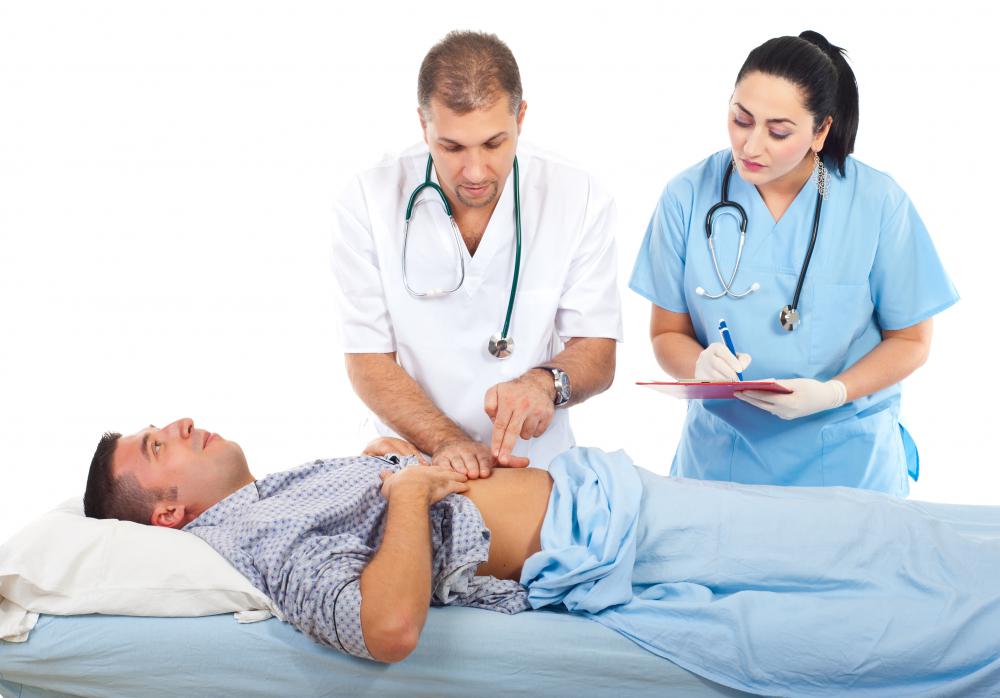At TheHealthBoard, we're committed to delivering accurate, trustworthy information. Our expert-authored content is rigorously fact-checked and sourced from credible authorities. Discover how we uphold the highest standards in providing you with reliable knowledge.
What is the Abdominal Wall?
In human anatomy, the abdominal wall refers to the boundary of the abdominal cavity which serves as a separation between it and other bodily regions. These walls consist of several layers, which vary somewhat between the front, sides, and back of the abdominal wall. There are several types of defects which can occur in this region of the body, most of which require surgical correction.
The structure of the abdominal wall consists of three main layers: an external, internal, and innermost layer. Blood vessels and nerves are located between the internal and innermost layers. The outermost layer of the abdominal wall is the skin, and just underneath the skin is a two-part layer known as the fascia. The Camper’s fascia, as it is called, is the more superficial layer, and is composed partially of fatty tissue. The Scarpa’s fascia is the inner, more fibrous part of the fascia.

The internal layer consists of three types of muscle, which are anchored to the innermost part of the abdominal wall. This innermost layer is made up of the fascia transversalis and the peritoneum. The fascia transversalis is a thin inner membrane which is continuous with the membranes of other bodily cavities. The peritoneum is the innermost lining, and covers most of the internal organs which fill the abdominal cavity.

Some types of defects which can occur in the abdominal wall are developmental in nature. Infants born with such defects have an abnormal opening in the wall. This often causes intestines and other organs to develop outside the body. While this in itself does not present a serious or life-threatening condition while the infant is in the womb, it must be corrected shortly after birth. Surgery is the only option to correct these birth defects, and depending on their severity, the child usually has a good chance of growing up to live a normal life.

Adults also experience abdominal wall defects, mainly in the form of hernias. A hernia occurs when an intestine protrudes through an opening or other weak area of the abdominal wall. Abdominal hernias are fairly common, especially in men, with more than half a million cases every year in the U.S. Most hernias simply cause a slight bulging where they occur, with little discomfort. Diagnosis can be made through a medical examination which may include an ultrasound, and surgery is the only effective form of treatment.
AS FEATURED ON:
AS FEATURED ON:















Discussion Comments
Sometimes a torn abdominal wall can feel like just a severe muscle strain.
In fact, tears in the lower abdominal wall are often mistaken at first for a groin pull.
However, torn abdominal muscles will usually present with spasms and bruising in addition to the "cramp" feeling, and will remain the same for several days at least.
Although there's little you can do about a torn abdominal muscle but let it heal on its own, you can take steps to avoid tearing your abdominal wall by warming up before exercise, and only doing those exercises that you are knowledgeable about and comfortable with.
@FirstViolin -- There are a number of things that could lead to a weak abdominal wall.
One of the most common causes in women is pregnancy. After having a baby, their abdominal wall muscles are stretched out and weak, leaving them vulnerable to hernias.
Also, abdominal weakness can be caused by stomach surgery. The entry point of the surgery is definitely going to be weaker than the surrounding area, at least for a while.
Finally, some men have an inbuilt weak spot where their testicles descended. This is one of the most common risk factors for inguinal hernias.
What could leave the abdominal wall weak?
Are there pre-existing conditions in the body that could cause that, or does it only happen after disease?
Post your comments